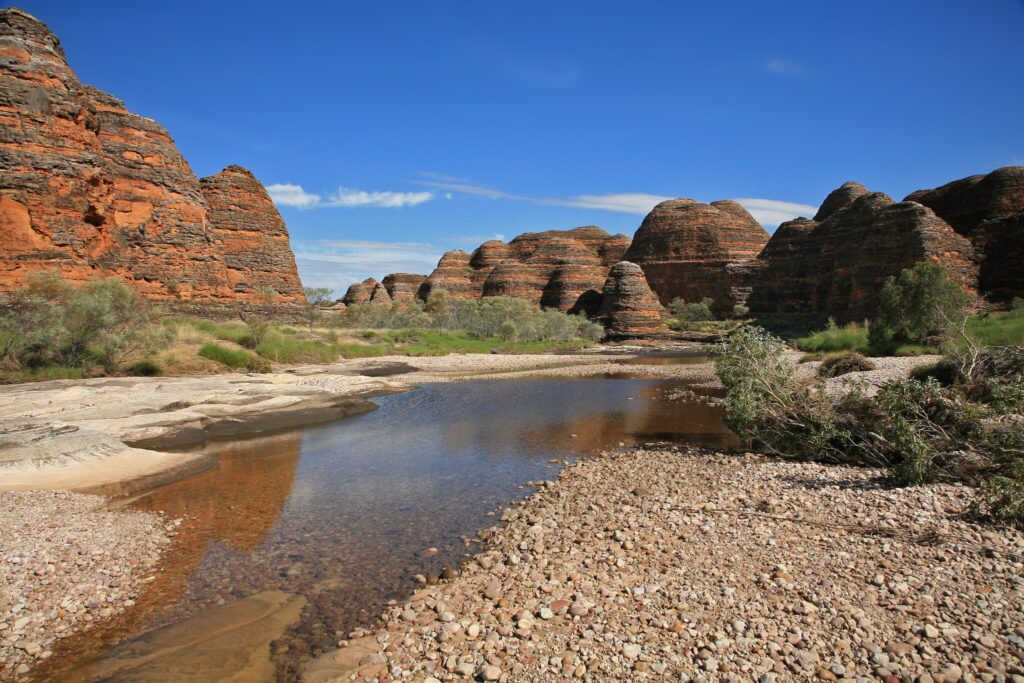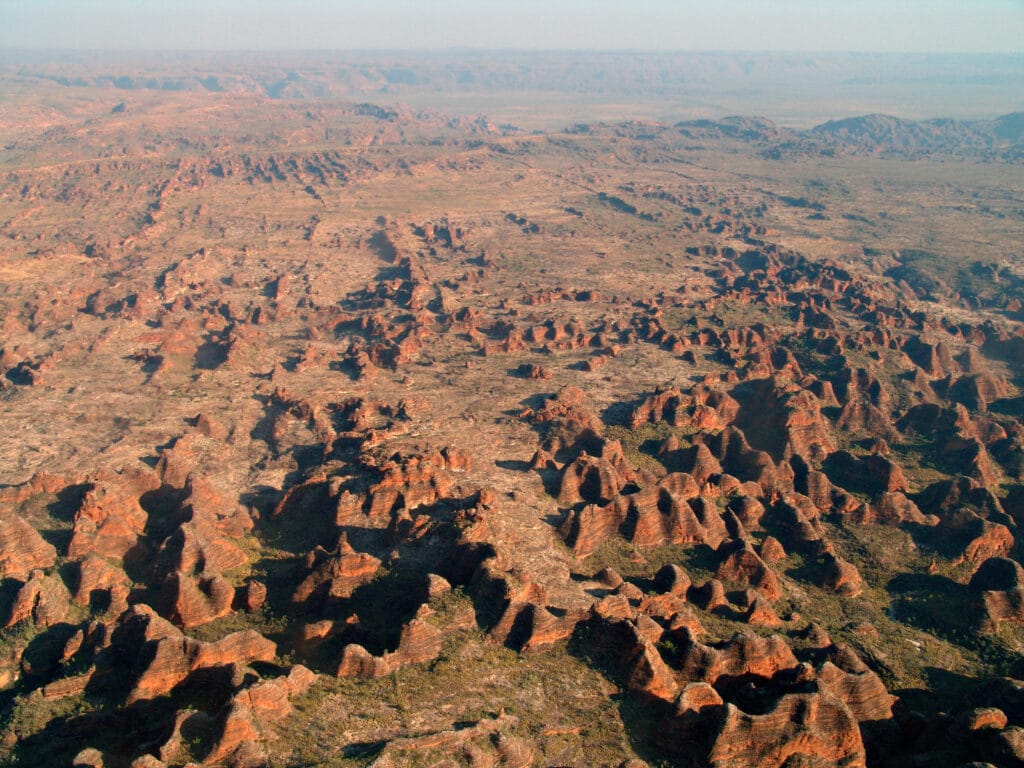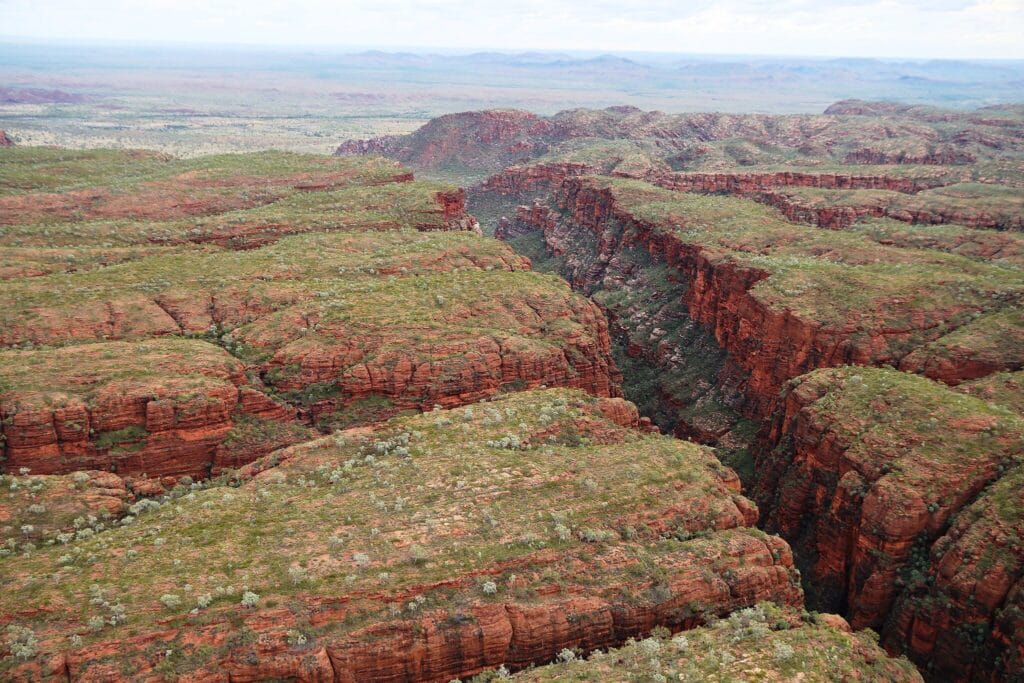Purnululu National Park
Purnululu National Park is home to the Kimberley region in Western Australia and is a stunning natural wonder. One of its most famous sights is the Bungle Bungle Range, known for its unique beehive-shaped rock formations made of sandstone. These incredible structures are truly breathtaking and make for an unforgettable experience.
The landscape, formed by the natural wear and tear of rocks and soil over millions of years, showcases the incredible strength of nature and the beauty of geological changes. The unique sights, like the vibrant colors that appear after it rains and how the sunlight shifts throughout the day, make the park an exciting place to explore.
Table of Contents
Where is the Purnululu National Park located?
Purnululu National Park is in the Kimberley area of Western Australia and covers an area of almost 240,000 hectares, which is filled with untouched nature. This park is recognized as a wilderness area, meaning it’s a place where you can experience the beauty of the natural environment without much human interference.
Inscription of Purnululu National Park
In 2003, Purnululu National Park was recognized by UNESCO World Heritage Site, which highlights its incredible beauty and cultural importance. This honor shows how unique the park’s natural scenery is and how it connects to our history. It’s a place that everyone should consider visiting, as it holds great value for both nature and people around the world.
What is the Purnululu National Park?

Purnululu National Park is one of Australia’s newest treasures and has quickly become famous around the world for its stunning scenery. The park features the impressive Bungle Bungle Range, which is the highlight of this beautiful area recognized as a UNESCO World Heritage site. It’s a place where visitors can experience nature at its most amazing. The park showcases a range of landforms and natural settings that represent the dry, semi-arid environment of Purnululu. This diversity creates a beautiful contrast to the impressive mountain formations in the area.
What is the history of the Bungle Bungle Range?
The Bungle Bungle Ranges in the park are a stunning example of how nature shapes the land over time. Through processes like weathering and erosion, the area’s ancient landscape has been transformed. These unique cone-shaped(three-dimensional) formations are the result of various natural factors, including the geology of the land, the climate, and the plants that grow there. Together, these elements have created the distinctive and fascinating shapes we see today.
How has it become Bungle Bungle Range?

The Bungle Bungle Range is an amazing natural wonder made up of ancient sandstone dating back to the Devonian age (around 375 million years). Over the past 20 million years, the rocks have been shaped by wind and rain, resulting in unique cone-like towers that resemble giant beehives. These impressive formations are not only visually stunning but also crucial for understanding our planet’s geology. Their distinctive black and orange stripes are a result of natural processes that have occurred over time, making the landscape even more captivating.
What is the scientific fact about the Bungle Bungle Range’s landform?

Geomorphologists (Scientists) who study the shape of the Earth’s surface have only recently noticed a fascinating phenomenon about how the Bungle Bungle Range was formed. The colorful bands you see there are created by tiny living organisms called cyanobacteria. These organisms can use sunlight to make their own food and form dark grey bands on steep rock surfaces. These bands are essential in keeping ancient sandstone formations stable and protected. These bands of cyanobacteria help guard these historical structures from erosion and damage.
The unique sandstone formations in Purnululu National Park are significant for scientists because they provide a clear example of how certain types of landscapes, known as cone karst, develop on sandstone. That characteristic makes the area a fascinating subject for study, and its scientific value contributes to the park’s overall attraction.
What is the Bungle Bungle Range famous for?
The Bungle Bungle Range is famous for its unique, cone-shaped hills that resemble striped beehives. These stunning natural structures are well-known around the world and are an iconic symbol of the park. The cliffs rise impressively to heights of up to 250 meters, and they change in appearance every day and throughout the seasons. After it rains or during different times of the day, their colors can look very different. Many visitors are also drawn to the seasonal waterfalls and pools that can be found in this beautiful area.
What is the Purnululu National Park famous for?
Purnululu National Park is well-known for its beautiful Bungle Bungles, which are tall, unique rock formations that look like beehives and have bright orange and black stripes. The park is home to various wildlife and features ancient rock art created by Aboriginal people. With its breathtaking views and rich history, Purnululu is a UNESCO World Heritage Site and is a favorite spot for people who love nature and adventure.
Why must we preserve Purnululu National Park significantly for us and future generations?
Preserving Purnululu National Park is essential for several reasons. First, it helps to protect the unique rock formations and the wide variety of plants and animals that live there. These natural wonders are essential for the health of our planet. The park provides homes for many species, some of which can only be found there and are at risk of disappearing.
Moreover, Purnululu is deeply meaningful to Indigenous peoples, who have firm spiritual and historical ties to the land. By keeping this park safe, we ensure that future generations can enjoy its stunning views, learn about its natural environment, and honor its cultural significance. Protecting Purnululu helps us develop a stronger appreciation for nature and a commitment to caring for our environment.
Why should you visit the Purnululu National Park as a visitor?

Purnululu National Park in Western Australia is a fantastic destination for anyone who loves nature. The Park is well-known for its incredible landscape, especially its unique beehive-shaped rock formations made of sandstone. That makes for a truly special and beautiful environment. Visitors can examine the Park by walking along various trails that offer stunning views and let them get up close to the natural wonders. There’s also a rich history and culture to discover, as the Park is home to the traditional people who have deep connections with the land. Whether you’re drawn in by the fantastic scenery or the cultural stories, Purnululu National Park has something for everyone.
Have you ever witnessed the breathtaking beehive-shaped sandstone domes of Purnululu National Park?
Don’t miss out on the opportunity to experience the awe-inspiring beauty and rich cultural heritage of Purnululu National Park! Whether you’re hiking through the striking terrain or learning about the local culture, every moment spent in Purnululu will leave you with unforgettable memories. Book your trip and explore the wonders of this incredible destination!
When you’re planning your adventure, enhance your travel experience by using trusted websites like GetYourGuide and Trip.com! These platforms offer a variety of enjoyable tours, activities, and accommodation options to suit every traveler’s needs.
- GetYourGuide offers a wide variety of unforgettable travel experiences. You can choose from tickets to Popular Attractions, Transportation Options, City Passes, Guided Tours, Hop-on Hop-off Bus Services, Water Activities, Day trips, and Trips that last several days in many locations around the world.
- Trip.com makes it easy to combine Flights and Hotels, Trains, Car Rentals, Airport Transfers and Attractions & Tours to create the perfect travel package tailored just for you.
Start your journey with our reliable travel partners and unlock the best of Purnululu National Park and beyond!
Disclaimer
In this post, affiliate links are included and those links are associated with well-known travel companies such as GetYourGuide and Trip.com. If you choose to purchase or book a service using those links, we may earn a commission at no additional cost to you. We focus on recommending products and services that are helpful to you and we appreciate your support!
Conclusion
We hope you find this information helpful for your next trip. If you want to learn more, check out our other travel blog posts. We cover many topics, including amazing places to visit and helpful travel tips. Whether you’re looking for hidden gems, new cultures, or helpful advice, there’s something for everyone.
Additionally, If you enjoyed the information we shared, don’t forget to explore our other travel product reviews to make your journey even better! Please take a moment to look through our previous posts and let your sense of adventure guide you on your next journey! We wish you happy travels and look forward to sharing more with you in our next blog post!




